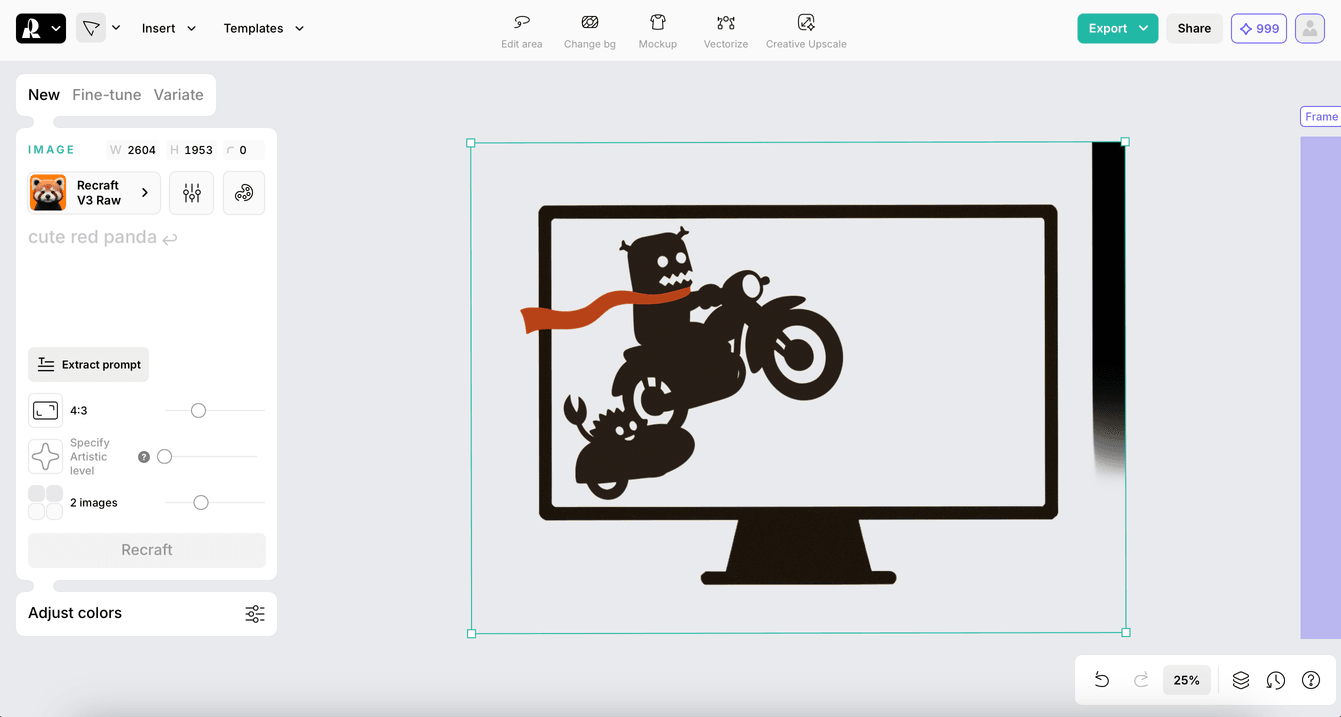How Recraft's lean team is challenging the AI image generation giants

Topics
In the high-stakes world of AI image generation, conventional wisdom suggests that only tech giants with massive resources can compete. Yet female-led London-based startup Recraft is proving this assumption wrong, carving out significant market share with a lean team and strategic thinking. Their story shows how targeted innovation and smart acquisition strategies can outmaneuver even the most well-funded competitors!
With Recraft recently raising a $30 million Series B round, this felt like the right time to share a story and talk about the work we were lucky enough to do with them (more on that later.)
Small team, big impact
Recraft has positioned itself as a formidable challenger to established players like Midjourney, despite operating with a fraction of the resources. Led by Anna-Veronika Dorogush, the company had raised a $12 million Series A round led by Khosla Ventures in Silicon Valley, together with former GitHub CEO, Nat Friedman; and has grown to an impressive 2.5 million users, including teams at Netflix and Airbus. This remarkable achievement comes from a team that has prioritized strategic focus over headcount.
Back in May of 2023, Recraft successfully launched on Product Hunt with thousands of people using the tool. Their growth has been explosive from there.
](/static/73b2ac1d647a56c587e35b31f92ea494/8f44a/recraft-slide.png)
Source: Business Insider
The startup’s approach centers on a key insight: in specialized markets, understanding user needs beats raw computing power. While larger competitors pour millions into general-purpose AI models, Recraft has laser-focused on professional designers – a demographic willing to pay for quality tools that improve their workflows.
Nikita Shamgunov, Partner at Khosla Ventures said in a statement: “Recraft delivers on professional workflows such as vector images, style controls and end-to-end content production, all powered by in-house built foundation models. Anna Veronika and her team have extensive experience in AI and machine learning, and we are excited to lead the company Series A.”
Hire Evil Martians
We built alongside Bolt.New and Recraft teams. Talk to us about shaping your AI product strategy
Vector-first: the technical edge
Recraft’s first clever strategy was identifying a gap in the market that larger players had overlooked. While Midjourney and other AI image generators focused on raster images, Recraft built their platform with vector output capabilities–making their tool immediately more valuable to professional designers who need editable assets. (Frankly, we have used Recraft more to enhance or generate images for the Evil Martians blog than their competitors.)

This focus on vectors wasn’t just a feature decision–it was a strategic differentiation that aligned perfectly with their target audience’s needs. Instead of competing on the general-purpose image generation that tech giants dominated, they created a specialized tool that felt purpose-built for professional workflows.
“What is unique about what we are doing is that we are not only providing image generation. We are also providing style control: the ability to create your own style and then generate images in your own style… This is important if you want to create a brand and grow it, create marketing materials, creating consistent adverts,” said Anna-Veronika in this interview with TechCrunch.
Meeting the giants on their own turf
Perhaps Recraft’s boldest move was their experiment with a Discord bot, entering the very platform where Midjourney had built its community. Instead of avoiding direct competition, they embraced it, recognizing Discord as a low-friction way to introduce new users to their capabilities.
The plan was simple but smart: give users a familiar chat experience where they could play with Recraft’s powerful tools. This way, potential customers could get a taste of what Recraft could do in a space they already hung out in–no complicated signups or learning curves. This approach allowed designers to directly compare Recraft’s output with competitors’ in real-time.
What began as an acquisition channel quickly evolved into something more valuable: a thriving community that now reaches an audience twice the size of Recraft’s X (formerly Twitter) following. In this space, users exchange techniques, provide direct feedback, and help each other maximize the platform’s capabilities, creating an ecosystem that larger competitors struggle to cultivate.
Building for quality, not just growth
While many AI startups race to add features or expand to new markets, Recraft’s team has maintained disciplined focus on improving core functionality. In October 2024, Recraft released their V3 model (initially teased as “red_panda”) and claimed the top spot on Hugging Face’s Text-to-Image Leaderboard by Artificial Analysis–an impressive technical achievement for a startup competing against the industry giants.
This focus on quality extends to their acquisition strategy. When the Discord bot gained popularity, there was temptation to expand its functionality, potentially competing with their own main platform. Instead, the team maintained discipline by keeping the bot focused on its primary purpose: introducing users to Recraft and channeling them to the full platform.
The power of strategic constraints
Recraft’s success demonstrates the counterintuitive advantage of constraints. With limited resources, they couldn’t pursue every opportunity or build for every use case. This forced strategic clarity that larger competitors often lack.
By building with Node.js and a microservices architecture, the team ensured their Discord integration could be repurposed for other platforms like Slack, maximizing the return on their development investment. This technical architecture reflects their broader business approach: build once, leverage many times.
The Evil Martians team distilled several powerful lessons from the Recraft’s Discord project:
- Treat community channels as full products. Success required the same strategic attention as their main platform, with focus on activation and retention, not just acquisition.
- Thoughtful onboarding is critical. A well-designed introduction to the bot’s capabilities dramatically improved activation rates, even among experienced Discord users.
- User experience shapes brand perception. Any friction with the bot directly impacted perceptions of Recraft’s main product, making UX investment a strategic necessity.
- Resist feature creep. Maintaining focus on the original goal of channeling users to the main platform required disciplined “no’s” to enhancements that would have undermined this purpose.
This disciplined approach ensured the Discord bot remained an effective gateway to Recraft’s full platform rather than becoming a competing product–a crucial distinction that preserved their business model while still meeting users where they were already active.
Maintaining the edge and the road ahead
Their journey so far proves that in the AI space, intelligent strategy and focused execution can outperform raw computing power and massive marketing budgets.For startups watching Recraft’s ascent, the lesson is clear: sometimes the path to competing with giants isn’t trying to match their scale, but rather finding the precise gaps in their offerings and building communities around specialized solutions that larger companies struggle to nurture.
AI development is often portrayed as requiring enormous resources, but Recraft stands as compelling evidence that small, nimble teams with the right focus can not only compete but potentially lead the next wave of innovation in image generation and beyond!



